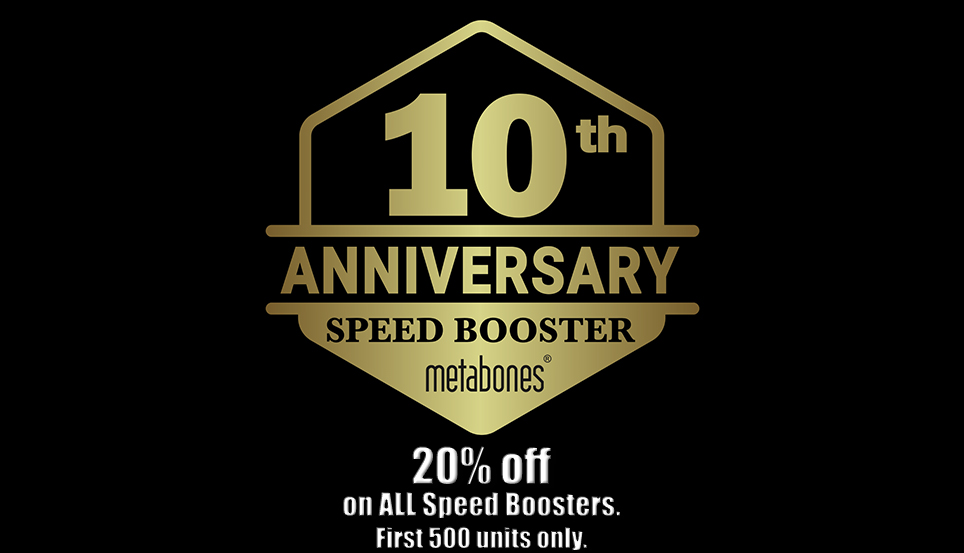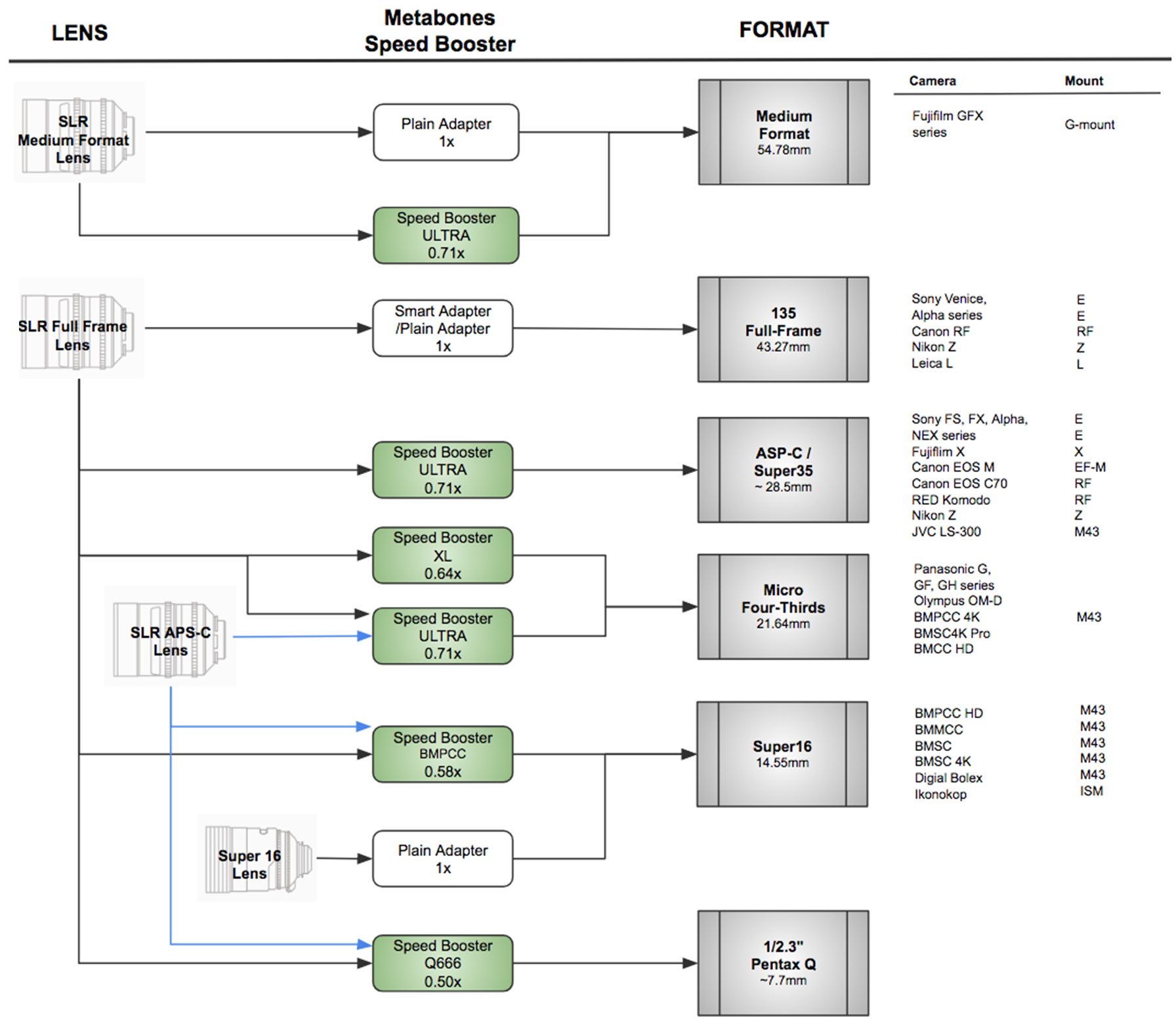
Petersburg, VA, USA, January 14, 2023 – Caldwell Photographic and Metabones® will celebrate Speed Booster®’s 10th anniversary on January 14, 2023, with a 20% discount on all Speed Boosters, limited to the first 500 units only.
Unsurpassed Optical Quality
Speed Booster® by Caldwell Photographic is the original, award-winning optics that make lenses faster(1), wider and sharper. The original Speed Booster has been superseded by Speed Booster ULTRA in September 2014, incorporating ultra-high index tantalum-based optical glass to achieve extraordinary optical performance with improved corner sharpness, less distortion and reduced vignetting. The plenitude of imitators attests to the significance of this new invention, but even after 10 years the genuine Speed Booster remains unsurpassed in optical quality. The difference is the most pronounced when a lens with a large maximum aperture (e.g. f/1.2 or f/1.4) is used.
Continuous Firmware Improvement
A Speed Booster sits between the lens and the camera and doubles as a lens adapter. Most single lens reflex (SLR) lenses and most mirrorless interchangeable lens cameras (MILC) are supported. With Metabones being the pioneer of the original Smart Adapter as well, the Canon EF mount and Contax N mount variants feature the most comprehensive electronic integration available, supporting phase-detection autofocus (PDAF), in-body image stabilization (IBIS), servo/power zoom lenses, cinema lenses and smooth iris where applicable(2). When an optical image stabilization (OIS) lens is used with certain continuous drive modes, Metabones will let the optical image stabilizer take a break in between shots to increase its effectiveness. Metabones embraces the kaizen philosophy of continuous improvement and is noted for firmware updates that continually add support for the latest cameras and their latest features. The final firmware for the original 2013 Speed Booster, v68, came out on December 14, 2021, 8 years, 11 months after the product’s introduction, while all other Speed Booster products equipped with smart electronics are still actively maintained and kept up to date. In 2013, the nascent mirrorless camera was lagging behind the traditional digital single-lens reflex (DSLR) camera in autofocus performance, especially when an adapted SLR lens was used. The original Speed Booster was noted for its unsatisfactory autofocus speed at its launch, even though it was as fast as the technology back then would have permitted. Fortunately, over the course of 10 years autofocus performance of mirrorless cameras has been increasing, and with Metabones actively pursuing the latest camera developments and upgrading its firmware, autofocus performance with adapted SLR lenses has improved dramatically. The same Speed Booster from 2013 with up-to-date firmware(3) has evolved from taking several seconds for one single-shot AF operation 10 years ago to high-speed continuous drive AF-C at up to 15 fps today on the latest mirrorless cameras with very good performance, an improvement of approximately 2 orders of magnitude.
Sub-f/1.0 from Exotic to Mainstream
The original Speed Booster and Speed Booster ULTRA have a maximum output aperture of f/0.9, achieved when an f/1.2 lens is used(4). In fact, the EXIF standard did not foresee lenses faster than f/1.0 and maxed out at f/1.0. For this reason, Metabones firmware has to display and record in EXIF the pre boost aperture to ensure the entire workflow from camera to post-processing is stable. The advent of Speed Booster ushers in a new wave of independent lens makers designing sub-f/1.0 lenses, which proliferate the market today, some of which are actually regular lens designs with builtin focal reducers.
From DSLR to Mirrorless Cameras
The Speed Booster plays a pivotal role in the transition from DSLR to mirrorless cameras because the first mirrorless cameras have APS-C or smaller sensors and photographers may already have a lot of existing lenses from the film SLR era. A mirrorless camera has a much smaller flange-to-sensor distance than a DSLR, making space available for optics. That is a key enabler of Speed Booster’s invention. In fact, it gets even better because a Speed Booster is shorter and more compact than a regular lens adapter. From the perspective of the lens, it may be helpful to think of the Speed Booster optically “enlarging” an APS-C sensor (1.5x or 1.6x crop) to almost the size of a full frame. Wide angles retain substantially their entire field of view, large aperture lenses retain their shallow depth-of-field and the disadvantages of small sensors are mitigated by an extra stop of light.
Significance on Videography
Speed Boosters are originally intended to adapt full-frame lenses to APS-C or smaller sensors. Still photographers who are already using full-frame digital cameras may find no use cases for them. For videography, however, many full-frame mirrorless cameras have cropped video modes. This first happened in 2015 when filmmakers used Speed Booster ULTRA on Sony A7R Mark II (ILCE-7RM2) because the Super-35 crop mode of that camera offered superior 4K video over the full-frame pixel-binned video mode. As new full-frame cameras continue to attain higher resolutions, it becomes increasingly difficult to read all the extra pixels out of the sensor quickly enough at video frame rates. Pixel-binning lowers the image quality of the video compared to 1:1 readout or oversampling, but if on the other hand, the camera oversamples a full sensor readout, the processing power required may generate excessive heat that may limit recording time. The third option is to have a center crop, which can be mitigated by a Speed Booster, thereby getting the best of both worlds – high still photo resolution, high video quality and good thermal management.
Who Invented This?
Speed Booster is the brainchild of Brian Caldwell (Caldwell Photographic) and Wilfried Bittner (WB Design). In 2013, for the first time, a compact, general-purpose focal reducer suitable for a wide variety of photographic lenses became available. A seismic shift in the landscape of the photo industry ensued, no pun intended.
What and Where to Buy?
The current Speed Booster line-up comprises of the following members:
- Speed Booster ULTRA has a magnification of 0.71x and is available for Canon EOS M, Canon EOS R, Fujifilm X and Sony Alpha (E-mount) cameras. It has a maximum output aperture of f/0.9 whichis achieved when an f/1.2 lens is used4. Both the maximum aperture and the focal length are multiplied by 0.71x. For example, an 85mm f/1.2 lens attached to a Speed Booster ULTRA becomes a 60mm f/0.9 lens.
- Speed Booster ULTRA for Micro Four Thirds has the same magnification of 0.71x but is optimized for the smaller image circle required by Olympus and Panasonic cameras with Micro Four Thirds mount. The maximum output is also f/0.9. In addition to full-frame SLR lenses, third party APS-C/DX lenses(5) can also be used.
- Speed Booster ULTRA for Blackmagic has the same 0.71x magnification but fits only on a Blackmagic Cinema/Studio Camera with Micro Four Thirds mount. Although Speed Booster ULTRA for Micro Four Thirds can also be used, the variant tailored for Blackmagic’s sensor stack is better optically on a Blackmagic camera.
- Speed Booster XL for Micro Four Thirds has a magnification of 0.64x and requires a full-frame lens to adequately cover the image circle of the Micro Four Thirds sensor. It has a maximum output aperture of f/0.8 which is achieved when an f/1.2 lens is used. Again, both the focal length and aperture are multiplied. A 50mm f/1.2 lens will become a 32mm f/0.8 lens.
- Speed Booster XL for Blackmagic has the same 0.64x magnification but is optically optimized for Blackmagic cameras.
- BMCC Speed Booster 0.64x is optimized for the smaller sensor of the original Blackmagic Cinema Camera with passive Micro Four Thirds mount. It is still fully equipped with active electronics so that it will also work on Blackmagic cameras with Super-16-sized sensors as well as the cropped 2.6k mode of Blackmagic Pocket Cinema Camera 4K.
- Speed Booster SUPER16 0.58x is for Blackmagic Design cameras with smaller Super-16mm sensors such as the original Blackmagic Pocket Cinema Camera (Full HD) and Blackmagic Micro Cinema Camera 4K.
- Hasselblad V to Fuji G mount (GFX) Speed Booster is a medium-format Speed Booster with 0.71x magnification, matching Hasselblad V’s 6×6 image circle to Fujfilm GFX’s 44mm x 33mm sensor size.
- Speed Booster Q666 is an advanced 6-element design for Pentax Q series cameras. It has 0.5x magnification, a world-record-breaking f/0.666 maximum output aperture and less than 0.666% distortion.
Genuine Speed Boosters by Caldwell Photographic are offered only by Metabones, either through its worldwide reseller network or its web store.
All models of Speed Booster products are offered at 20% discount:
https://www.metabones.com/products/?c=speed-booster
Compatibility Diagram
 Recommended Reading
Recommended Reading
• Speed Booster White Paper:
https://metabones.com/article/of/sb-white-paper
• Speed BoosterULTRA 0.71x for MFT Mount White Paper:
https://metabones.com/article/of/ultra-mft-white-paper
Brian Caldwell (Caldwell Photographic)
Brian Caldwell earned a Ph.D. in Optics from The University of Rochester in 1988. He has more than 30 years experience in the fields of lens design and optical engineering, with more than 100 different manufactured products to his credit. In 1988 he founded Optical Data Solutions to develop LensVIEW, an extensive database of more than 30,000 optical designs from the patent literature. After working as an optical designer first at Projectavision, and then at Concord Camera he founded Caldwell Photographic Inc. in 2001 to do independent consulting, and to develop and manufacture optical products. In 2014 Brian embarked on the design and manufacture of a series of anamorphic prime lenses. The result, announced in 2019 as the Caldwell Chameleon anamorphic lenses, combine the widely admired design and look of classic anamorphic optics with highly efficient and skilled manufacturing to produce a series of lenses that will be as affordable as they are desirable.
Wilfried Bittner (WB Design)
Wilfried Bittner is a mechanical engineer specializing in opto-mechanics, and has more than 45 years experience in the optical and photographic industries, both in Germany and Hong Kong. Wilfried founded WB Design in 2006 to do specialized mechanical design and product development work.
Footnotes:
(1) “Speed” or “fast” refers to the maximum lens opening relative to the effective focal length, i.e the smallest f number.
(2) PDAF and IBIS require camera support; AF, OIS, servo/power zoom, and smooth iris require lens support.
(3) The original Speed Booster does not have a USB port and firmware update is a factory service procedure. The upgrade itself is free but the customer pays for shipping. All subsequent Speed Boosters are equipped with USB ports and the latest firmware can be downloaded from Metabones’ website.
(4) Most lenses marketed as f/1.2 are technically 1/3 stops faster than f/1.4 lenses, or f/1.26.
(5) Canon EF-S lenses cannot be used because they have rear protrusions and will not be physically fit.
